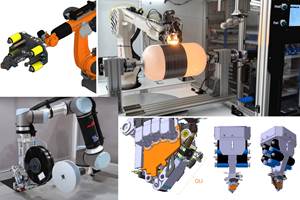Composites 4.0: digital assistants, edge computing and the future of smart factories
Plataine reviews developments and discusses where composites manufacturing is headed.
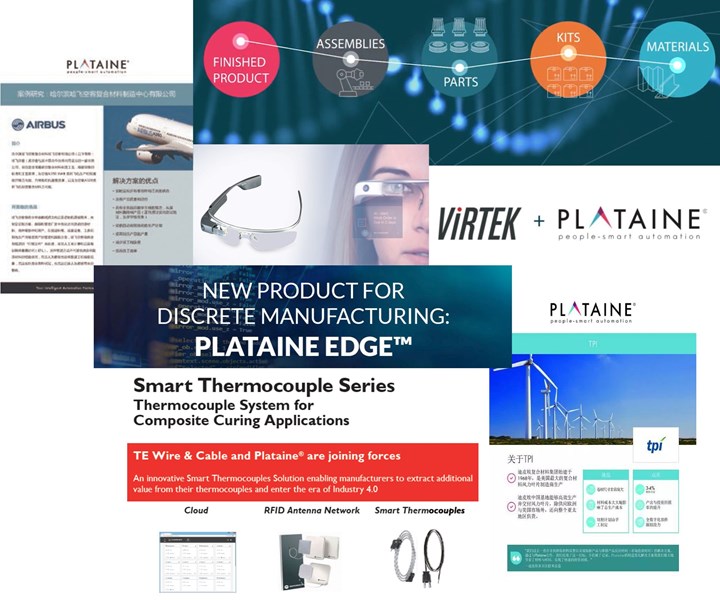
Plataine (Waltham, Mass., U.S. and Tel Aviv, Israel) has been at the forefront of Industry 4.0 in composites since the beginning. When I met Plataine president Avner Ben-Bassat in 2014, no one was really talking about Industry 4.0. In fact, the case study we published in 2015 with Israel Aerospace Industries (IAI, Tel Aviv) didn’t even mention 4.0, but instead described how Plataine’s Total Production Optimization (TPO) software helped IAI ramp production, reduce costs and improve quality.
In my 2016 blog “Digital twin, digital thread and composites”, it was Ben-Bassat who educated me on these concepts as well as where 4.0 technology was headed. Now, I have reached out again to better understand Plataine’s expansion into tool tracking and management, its partnerships with Google, Airbus and others, and production planning via its new Plataine Edge software. My goal is to once again gain insight into what these and other developments portend for the future of composites manufacturing.
Plataine will be presenting at Carbon Fiber 2019 (Nov. 19-21, Knoxville, Tenn., U.S.) on Edge Computing for Advanced Composites Manufacturing and will also participate in the panel discussion: Developing standards for the Smart CFRP Factory of the Future. Make plans to attend if you can!
Expansion into Tool Tracking & Management
Plataine’s first applications in the composites market focused on optimizing the cut-planning of prepregs and the management of materials, their shelf-life and utilization, which reduced waste and increased efficiencies. The software integrates with a company’s existing enterprise resource planning (ERP) software and computer aided design (CAD) programs like CATIA or Nx, forming a bridge between the two and augmenting with data gathered from sensors on materials, machines, tools and parts.
Plataine’s next step was to incorporate layup molds, but why add tool tracking? Ben-Bassat explains with an example:
“A prepreg has 50 hours of out-life, but the job normally takes 30 hours. AI, however, is predicting a bottleneck with the tool and alerting that the job will take 60 hours. Thus, tool tracking comes into play as does material tracking.”
Most companies have a schedule for tool maintenance, explains Ben-Bassat, which can be time-based (every month) or duty-based (every 100 parts). “But this maintenance becomes more complex with hundreds and thousands of tools,” he notes. “Plataine’s software collects information on each tool’s usage and output, which parts they’ve been used to produce and with which processes as well as information about the quality of the finished part. We then analyze this data to address quality issues and prevent future issues, but also to guide decisions that maximize efficiency.”
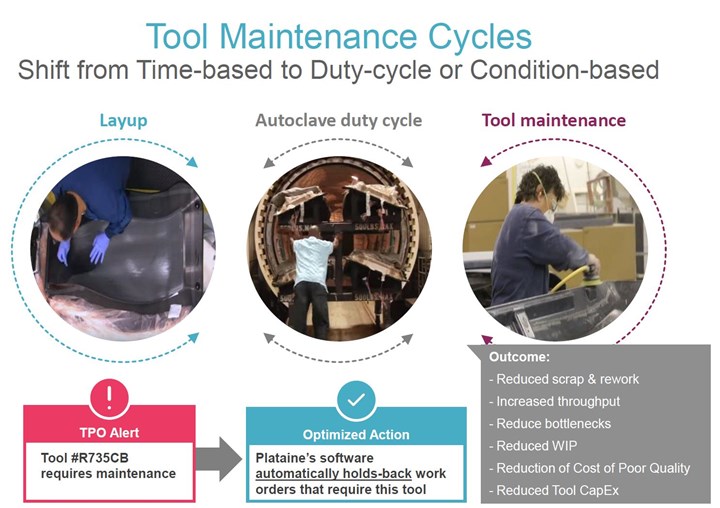
Tool tracking in Plataine’s software for Composites 4.0 production allows manufacturers to optimize tool usage, maintenance and capital expense. SOURCE | Plataine.
Ben-Bassat says that with this knowledge of what the tools have been doing (parts, process, quality), Plataine’s software can look at individual situations. “Say you have two tools: one needs maintenance after 9 cycles and another after 10 cycles. We analyze how and why these tools are different. Too little maintenance risks quality issues, but too much maintenance reduces throughput. Also, buying tools is a serious investment, with some tools costing hundreds of thousands to millions of dollars. So, manufacturers want to avoid buying new tools if possible, but when necessary, they need to ensure these tools will be most efficient.”
Another issue is that tools often get lost. “For example, a worker may have forgotten a tool in tear-down,” Ben-Bassat relates. “But now someone has to go find that tool and get it back into production. So, you not only lose that person’s time, you also lose that tool’s layup productivity. With our software, the manager will get an alert that tool #10 is sitting in tear-down for 3 days. The manager can then respond and address this.”
After layup tools, Plataine expanded again to include tracking of thermocouples, drills, drill bits and consumables. “These are all aspects of the very large, complex picture that is composites production. Materials, tools, equipment — it’s all connected. Our vision is to monitor as many factors as possible and not only identify the production issues but present and implement solutions.”
Intelligent digital assistants
“We see the software as a digital assistant which constantly analyzes production data, offering our operators and managers alerts and smart recommendations in real-time," says Ian Pearce, Head of Production at Renault Sport Racing (Enstone, United Kingdom). Renault’s Formula 1 team uses composites extensively in the chassis and gearbox of its racing cars and, in 2018, chose to implement Plataine’s software in its composites production system. Plataine’s software manages materials, guiding production staff as to which prepreg rolls to use (based on tracking out-time and use of remnants) as well as where the prepregs they need are physically located — whether in frozen storage or on the production floor.
The prediction that Pearson discusses above requires an understanding of the current production state and a history of what has happened before, explains Ben-Bassat. “It’s about data collection via sensors in materials, machines and on parts so that we know who is doing what at any given time in what environment. We can then identify a pattern and predict a bottleneck in machine #7, for example. Or we may say this doesn’t look right, there may be a problem developing in machine #7.”
Ben-Bassat discusses the system’s intelligence: “When you shop in Amazon, it tells you what other customers like you have bought. How does it do this? Amazon’s algorithms collect your click history plus many other parameters. This data creates a historical repository. Similarly, we use a large pool of historical data from all of the sensors on materials, machines, tools and parts. But these also tell us what is happening now. We then use AI — essentially analytical algorithms — to look at all of that data, to identify patterns and to predict problems.”
But identifying potential problems is not enough, says Ben-Bassat. “Our software will also make a recommendation. This is the next frontier: predicting back-ups, overcapacity and tool maintenance, so that you can better allocate materials, take a tool off the line because it is slowing down production or, alternatively, stretch out a tool’s maintenance cycle to maximize production. There are myriad decisions that we want to influence and improve.”
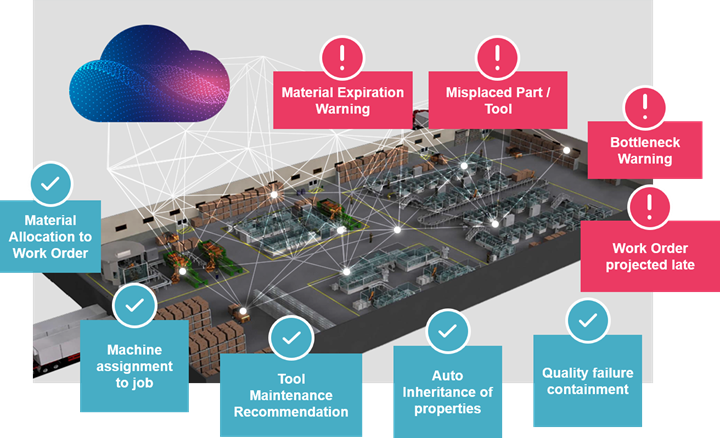
Plataine software uses data from materials, machines, tools and parts to identify patterns in composites production and predict potential problems. SOURCE | Plataine.
“The software learns the typical process for a given part,” Ben-Bassat continues. “For example: freezer, ATL, autoclave, machining, final quality assurance (QA). But then, suddenly, someone went from step 5 to step 7. Or, a part went backward in steps, which implies a quality issue. So, the software has identified patterns and can alert issues such as when a step has been missed.” These issues have implications on production metrics. The sooner they can be identified or predicted, the sooner they can be addressed so that production is kept running smoothly.
“Many dashboards are available that require someone monitoring the data in order to make a decision — i.e., there is little automation and no AI,” says Ben-Bassat. “Our software is unique because it predicts the issues and then suggests how to fix them. For example, the software will see that parts on machine #8 tend to fail because it ran at 60°C not 62°C and ran on Mondays when the operator was really tired. There are so many occurrences like this, quality issues that are actually a function of many variables. Our software can identify these issues and present a diagnosis, prognosis and treatment.”
Using the data from all of these sensors, the Plataine software is essentially building an interconnected web of digital threads. “You have specific parts made from specific materials by specific employees using certain processes, equipment and tools with specific consumables and in certain environmental conditions,” says Ben-Bassat. “We use a variety of software tools from Google, Amazon and others, as well as many developed in-house, to provide a total solution that analyzes all of this data in real time and identifies patterns, trends, QA issues and bottlenecks, opportunities for improvement, etc. With machine learning, the system then makes recommendations. This is key — not to just alert, but to fix the bottleneck that you didn’t know you were going to have and do that as early as possible.”
Plataine Edge
Plataine’s latest software, Plataine Edge, advances this ability to identify and solve production bottlenecks before they occur, by using edge computing to reduce latency and improve production-level system performance. Edge computing allows data from internet of things (IoT) devices to be processed at the edge of those devices, where the data is being generated, instead of being sent via long routes to the cloud and back. It’s not that cloud computing power is eliminated, it’s more that it is being distributed to the production line. Cutting this distance between data generation, processing and feedback into the IoT system reduces the lag time, or latency. Minimizing latency is crucial for Composites 4.0 production lines to operate in real time.

Partnerships with Airbus, Google, etc.
“Our network of partnerships is critical to our strategy, because nobody can do this alone,” says Ben-Bassat. In 2016, Plataine announced its partnership with the Composite Technology Center (CTC, Stade, Germany), a subsidiary of Airbus. “Our partnerships are different in nature. Our collaboration with CTC is expanding throughout Airbus,” he notes. Meanwhile, Plataine’s partnership with the University of Sheffield’s Advanced Manufacturing Research Centre (AMRC, Sheffield, U.K.) is aimed at promoting innovation and competitiveness in U.K. and European manufacturers, not just in aerospace, but also in automotive and other industries.
“We also have partnerships with a variety of industry leaders across all industries, for example, Steelcase. We help them with composites and we then learn about trends and developments in other industries and can capitalize on these for composites. Through our partnerships with composites technology companies, like Airborne and TE Wire and Cable for smart thermocouples, we learn more about how to obtain data and analyze it. When is it the right time to pull a thermocouple off the line or replace it?”
In 2019, Swinburne University announced it would partner with Plataine along with Fill (Ried im Innkreis, Austria), Quickstep (Bankstown Airport, Australia) and Arena2036 (Stuttgart, Germany) to build Australia’s first Industry 4.0 Testlab for composites production. The program is funded by the Australian government with the goal of high-rate composites manufacturing that will be flexible and capable of learning. “This collaboration with Swinburne is important, but it is one point among many in the global push for high-rate production of composites.”
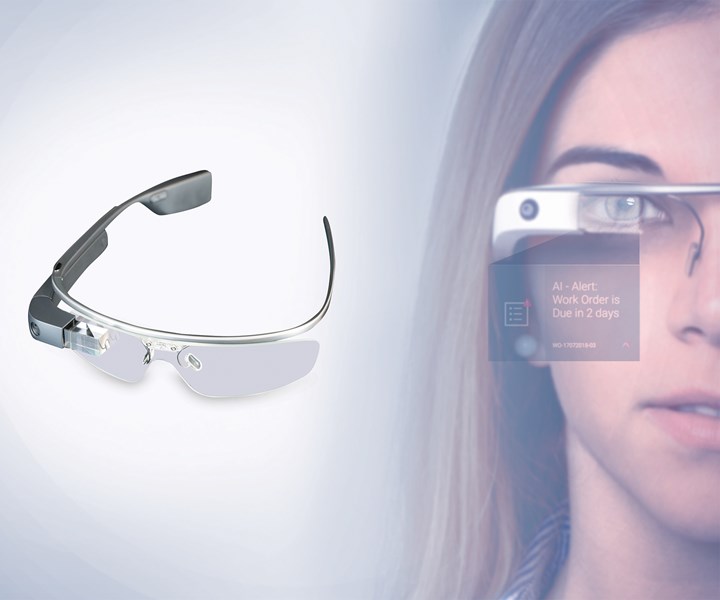
Plataine partners with Google Glass to provide a wearable interface for its digital assistant software for managing composite materials, tools and processes. SOURCE | Plataine.
Digital assistant via Google Glass
Though much of Plataine’s partnership with Google is behind the scenes, there is one part that is actually in front of the user. “Google Glass is a user interface worn by the operator that has an earpiece and microphone, basically equivalent to a tablet computer or phone but just in a different form,” explains Ben-Bassat. “It uses Google’s natural language processing capabilities, but even more advanced — it can understand any language and overcome ambient noise. When the operator talks through the Google Glass microphone in any language, Google can translate the question and formalize it for Plataine’s software, which then answers the question.” He gives an example:
TECHNICIAN: “What’s my next job?”
PLATAINE via GOOGLE GLASS: “The next job is #102.”
TECHNICIAN: “Which tool do I use?”
PLATAINE via GOOGLE GLASS: “Joe, use tool #5, which is on shelf 14A.”
“Our partnership with Google combines our knowledge of manufacturing with Google’s broad expertise to provide a digital assistant for managing composite materials, tools and processes,” says Ben-Bassat. “Our software and the Google Glass platform enable the operator or technician to do his/her job and improve throughput, reduce mistakes and facilitate advancement up the learning curve.”
Software implementation, connected supply chain and cyber security
Ben-Bassat says first and foremost, Plataine exists to give a business solution. “So, implementation starts by identifying the customer’s pain points: what do you want to solve and achieve? The answer is often production rate/yield or quality/rework. We then visit the facility and do a process analysis.” The latter is a kind of due diligence with different levels of personnel, from management to factory floor, to give a broad, thorough picture.
“We then identify if Plataine can help and how, followed by a step-by-step approach,” says Ben-Bassat. “We advise starting with one line and roll the software out first there and then gradually expand. This also gives time to manage the change and get user buy-in. Meanwhile, we get feedback to see where more training is needed, etc.”
What about the current drumbeat from OEMs regarding a connected supply chain? “This definitely creates additional challenges with trying to implement Composites 4.0,” Ben-Bassat replies. “An OEM will say that it wants to connect all of its suppliers because this helps it tighten control and lower costs, but how does the whole chain manage data security? There is no global standard, by the way. For now, the OEM can give you a list of things to comply with and once you demonstrate compliance, you can be accepted. So, Plataine has spent a lot of time on this because, “If we can’t show compliance with the OEM’s requirements, then we can’t sell our software,” Ben-Bassat notes.
“We draw from local expertise and knowledge,” he adds. Israel is a world leader in cyber security. “We have excellent tools here in Israel (e.g., penetration test software) that we can buy to uncover any weaknesses we may have. Plataine is investing heavily in this, as we must.”
Additive Manufacturing and Recycling?
“We are seeing the additive manufacturing (A.M.) industry, in general, transition from prototyping to serial production,” says Ben-Bassat. Manufacturers must track the pedigree of incoming materials as well as the number of times metal and composite powders and/or themoplastic scrap are recycled, for example. “This cycling may be going on in hundreds of machines and, especially for aerospace parts, traceability must be maintained. It is very complex and a big challenge,” he says. “But there is also a challenge of repeatability in both process and parts. For example, one part went through 5 blends and 10 recycles while another machine and part went through 6 blends and 9 recycles. Are these two parts the same? So, this is not just material data, but also very large amounts of data from machines that must then be correlated to QA and the production environment. We believe Plataine can help do a better job of predicting production and part performance and can play a supporting role in both AM and recycling. We not only have the software infrastructure, but also the knowledge base. If we can help our customers ramp up in their ability to use AM and recycling, especially in composites, then this is good for the whole industry’s flexibility, productivity and sustainability.”
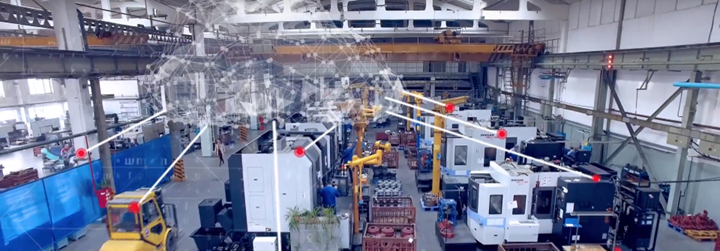
Where is Composites 4.0 headed?
“This is an intense period in a positive sense,” says Ben-Bassat. “Industry dynamics are creating a need for production solutions. We are expanding our footprint on the manufacturing floor and focusing on optimizing each manufacturer’s composites production.” He agrees that it seems many companies are not sure what to do nor how to do it. “I think it is hard for some companies to understand how game-changing Industry 4.0 is for throughput, capacity, etc. The business impact is so significant, it really will affect which companies pull ahead and which won’t be able to compete.”
“Automation is moving forward,” he adds. “That is not going to stop. We have seen that software hardly ever replaces people, but instead makes the team better.” In other words, it frees up operators, technicians and management to tackle new problems and new developments — to anticipate what customers will need next and to pursue solutions that will dramatically alter the calculus of composites’ competitiveness and sustainability. “Yes, we are pursuing a philosophy, but most of all, a very real business value proposition.”
Related Content
The next evolution in AFP
Automated fiber placement develops into more compact, flexible, modular and digitized systems with multi-material and process capabilities.
Read MoreSTUNNING project completes lower half of MFFD
Clean Sky project has delivered the 8 × 4 meter welded aerostructure component, aided by advanced thermoplastic composite technologies and smart robotics.
Read MoreThe potential for thermoplastic composite nacelles
Collins Aerospace draws on global team, decades of experience to demonstrate large, curved AFP and welded structures for the next generation of aircraft.
Read MorePEEK vs. PEKK vs. PAEK and continuous compression molding
Suppliers of thermoplastics and carbon fiber chime in regarding PEEK vs. PEKK, and now PAEK, as well as in-situ consolidation — the supply chain for thermoplastic tape composites continues to evolve.
Read MoreRead Next
“Structured air” TPS safeguards composite structures
Powered by an 85% air/15% pure polyimide aerogel, Blueshift’s novel material system protects structures during transient thermal events from -200°C to beyond 2400°C for rockets, battery boxes and more.
Read MoreDeveloping bonded composite repair for ships, offshore units
Bureau Veritas and industry partners issue guidelines and pave the way for certification via StrengthBond Offshore project.
Read MoreVIDEO: High-volume processing for fiberglass components
Cannon Ergos, a company specializing in high-ton presses and equipment for composites fabrication and plastics processing, displayed automotive and industrial components at CAMX 2024.
Read More













.jpg;maxWidth=300;quality=90)
